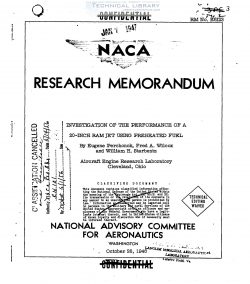naca-rm-e6i23
- Version
- 164 Downloads
- 1.06 MB File Size
- 1 File Count
- March 14, 2017 Create Date
- March 14, 2017 Last Updated
National Advisory Committee for Aeronautcs, Research Memorandum - Investigation of the Performance of a 20'' Ram Jet Using Preheated Fuel

The performance characteristics of a 20- inch ram jet designed
at the NACA Cleveland laboratory and operated with preheated
unleaded (62 octane) fuel in the Cleveland altitude wind turmel are
presented and analyzed.
The results of this investigation indicated an improvement
in the combustion efficiency and operating range of the ram .jet
when using preheated fuel. Concomitant increases were obtained in
the temperature ratio across the unit, the over-all efficiency, and
the not thrust. At a free—stream Mach number of 1.20, a combustion
eff ici one;r of 84 percent and an over-all efficiency of 8.13 percent
were obtained. Sufficient heat could be recovered from the ram-jet
shell to preheat the fuel to the desired fuel injection temperature.
As a part of the general program to evaluate and improve the
performance of the ram-Jet engine, a series of- experiments are being
conducted at the MCA Cleveland laboratory to determine the per-
formance improvements that might be obtained by the use of prelmated
fuel. It was anticipated that preheating and the resulting flash
vaporization of the fuel as it left the fuel injector would improve
mixing of the air and fuel and increase the rate of flame propa-
gation. Improved combustion and over-all efficiencies would like—
wise be expected.
Two methods of preheating the fuel are discussed: a regenerative
heating system in which the fuel was circulated through coils around
the combustion-chamber shell; and, to expedite the research, a
system with an erbenzal heat source preheating the fuel. The regen—
erative system also cooled the combustion-chamber shell. The
performance of the ram Jet using preheated fuel is compared with
the performance presenteQ in reference 1 for a similar ram Jet
operating under the same cond‘1tiohs using unheated fuel.
The performance characteristics of a 20- inch ram Jet were
investigated in the _Cleve1and altitude wind tunnel over a wide range
of operating conditions. The general arrangement of the ram fat
in the tunnel (fig. _)' was similar to that of reference 1. The unit
was mounted in the test section below a 7—foot—chord wing, which
was supported at its tips by the wind—tunnel balance frame. Dry
refrigerated air at approxinately atmospheric pressure was supplied
directly to the ram.jet through a pipe from the wind-tunnel make-up
air duct and was throttled to provide the desired diffuser—inlet
total pressure. The tail nozzle exhausted directly into the wind
tunnel, the pressure of which was varied to obtain different values
of ram-pressure ratio across the unit. A sealed slip Joint inserted
between the ram pipe and the diffuser inletL ferded free movement
of the model.
| File | Action |
|---|---|
| naca-rm-e6i23 Investigation of the Performance of a 20'' Ram Jet Using Preheated Fuel.pdf | Download |

Comment On This Post